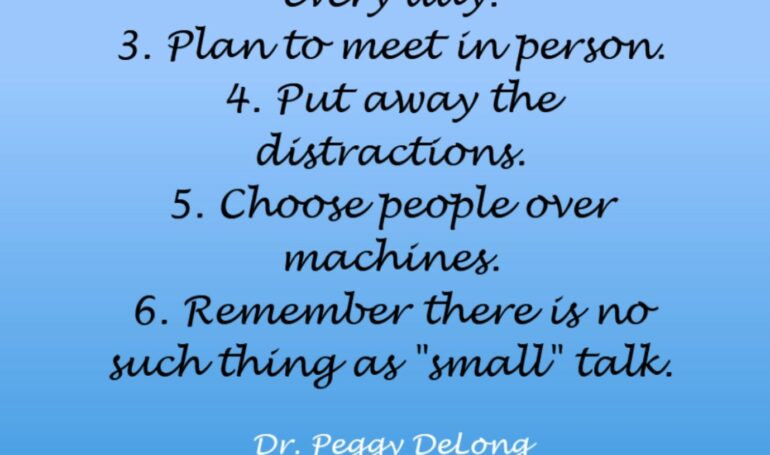
Cultivating Social Connections
The #1 factor related to happiness and satisfaction in life is our relationships, our connections. FEELING connected. That is why when I started my on-line program to go along with my book, I made cultivating our relationships the first topic.
Here are some suggestions I have for connecting with people, taken from my book: Feeling Good: 35 Proven Ways to Happiness, Even During Tough Times. Pre-order my book now, and you’ll receive one YEAR free membership in the companion group, Feeling Good with Dr. Peggy.
One YEAR! That’s how strongly I feel about supporting people. You can pre-order by clicking here. The gift is only available for pre-orders.
Make eye contact (when this does not go against your cultural norms).
I don’t mean look people in the eye in a creepy way. I’ve just noticed that people don’t really look at each other anymore. We are social beings, and we are losing connection with each other. We’re busy multi-tasking, looking at our phones, being distracted by to-do lists. This lack of connection is leading to a feeling of budding emptiness, or for some, full-blown emptiness and profound loneliness. So look your child or partner in the eye when he or she is talking to you and look the grocery store cashier in the eye when he or she asks you how you are doing. You can really get a sense about someone and make a connection with simple eye contact. Making eye contact releases oxytocin in the other person, fostering connection by producing a feel-good, cared-for feeling.
Every day make a point to connect with 2 people.
Reach out to someone who supports you and makes you feel good. Reach out to someone who could use your support. One idea is to scroll down to the bottom of your text messages and reach out to someone you have not connected with in a long time. Connect and reconnect.
Make a plan to get together in person with someone.
Studies have shown that nothing can replace in-person meetings. Talking on the phone may help you feel connected, texting/email/social media may help you feel connected, but do not let this replace in-person meetings. Call a friend for coffee or a walk and get together! During a time of social distancing, you could choose a location where you’re able to sit outside and enjoy a beverage. You could also choose a less-traveled sidewalk or trail wide enough to comfortably walk apart.
Put away the distractions when connecting.
It’s not enough to make eye contact. In order to be fully engaged with someone, you need to eliminate or minimize distractions. If your child is wanting to tell you a story about school and you are on the computer, don’t just look at your child. Close the computer screen. Turn the phone off. Through these actions, you communicate to your child that you are fully present and paying attention.
One study found that simply having a smartphone in sight significantly lowered attention to a task. In the study, the phone was turned off and was upside down, yet it still served as a distraction. So put them out of sight. This applies to the home and out in the world.
Also consider what message you’re sending. When you make a conscious effort to put your phone away, you are telling whoever you are with, “You are enough.” So next time you are waiting at the doctor’s office with your child, resist the urge to whip out your phone. Look at your child and start a conversation. If you are out to dinner with your spouse, keep the phone in your car. One study found that having a cellphone visible while two people were talking made for less meaningful and engaging conversation. The presumption was that the presence of the phone signified that the people could be interrupted at any point during the discussion. This caused them to naturally settle into more trivial topics of conversation.
Choose people over machines and technology.
We often choose machines over people because we think it will be convenient. We think we will save time, and that the saved time will make us happy. Sometimes our brains do not know what is best for us. What makes us happier than having more time is feeling connected. So instead of using the bank ATM, interact with the bank teller in the drive-through or lobby. Instead of using the self-checkout at the grocery store, choose the lane with a clerk, and interact. Even introverts report more happiness when they have interacted with others.
Remember that there is no such thing as “small talk.”
Every seemingly “small” interaction matters. These add up and make us feel connected to our communities and the world. So talk to the person next to you on line. Use the receptionist’s name that’s on her name tag. Compliment the stranger you pass in the parking lot if you just love her shirt.
Sounds simple? That’s because it is! Yet when you make some changes in your life, you will FEEL powerful results. What simple change can you make today toward FEELING GOOD?


Leave a Reply